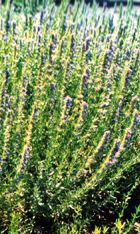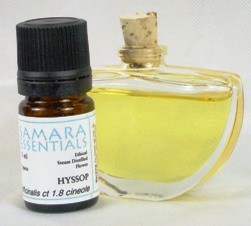
Plant Part: Flower/Leaf
Extraction: Steam Distilled
Growing Practice: Ethical
Country of Origin: Spain
Odor Type: CAMPHOROUS

Odor Characteristic: Hyssop essential oil has a soft, cineolic, lavandaceous odor character. Dryout is creamy, powdery, woody and slightly herbaceous.
Refractive Index: 1.48600 to 1.49000 @ 20.00 °C.
Specific Gravity: 0.89900 to 0.94000 @ 25.00 °C.
Appearance: pale yellow clear liquid
BioChemical Class: Ketone
CAS No: 8006-83-5
Perfumery: Will introduce rich, warm and spicy-herbaceous notes and is a welcome addition to citrus colognes, and light aldehydic fragrances as well as heavy oriental bases. Hyssop blends well with citrus oils, lavender, rosemary, myrtle, geranium, etc.
(1) Aromatherapy for Massage practitioners, Ingrid Martin, Lippincott, Williams & Wilkins![]()
(2) Essential Oil Safety, Tisserand and Balacs, Churchill Livingstone 1995)
(3) Aromatherapy Science: A guide for healthcare professionals, Maria Lisa Balchin, Pharmaceutical Press
The information provided on these pages is not a substitute for necessary medical care, nor intended as medical advice. Always keep aromatic extracts tightly closed and in a cool, dark place, out of reach of children. Never ingest aromatic extracts. Always dilute aromatic extracts when applying topically and avoid areas around eyes or mucous membranes. If redness or irritation occurs, stop using immediately and contact your health provider if necessary.![]()
all images and content copyright ©2000—2020 by suzumebachi design and samara botane





